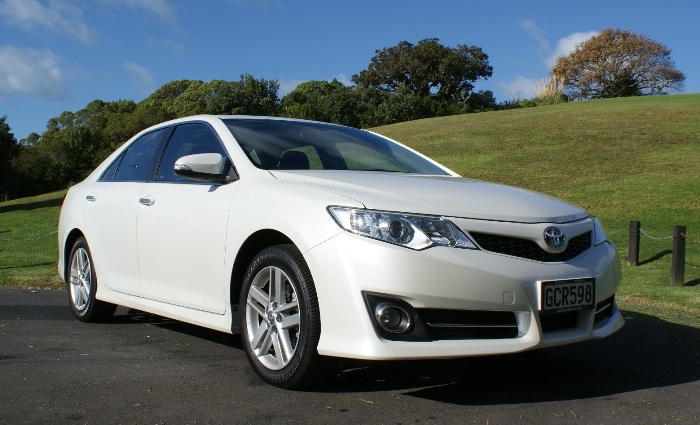
Car reviews
Read our expert car reviews - where we give insight into the latest vehicles to hit our roads.
17 August 2012
Toyota’s front wheel drive Camry came into existence in 1982 as the replacement to the rear wheel drive Corona. The compact car changed to a mid-size over the years. Over fifteen million vehicles were sold worldwide by the end of 2011, making it the second best selling Toyota car after the Corolla.

Toyota’s front wheel drive Camry came into existence in 1982 as the replacement to the rear wheel drive Corona. The compact car changed to a mid-size over the years. Over fifteen million vehicles were sold worldwide by the end of 2011, making it the second best selling Toyota car after the Corolla.
Toyota New Zealand General Manager of Product Planning, Neeraj Lala says, “We’re likening the seventh generation Camry to a Swiss Army Knife. It’s got all the tools required during the work day, plus it’s got the flexibility for use in your private life as well.”
The latest seventh generation Camry is available in four petrol and two hybrids models starting with the GL, Atara S, Atara SX, Hybrid and Hybrid i-Tech.
A bigger and more powerful 2.5L four-cylinder engine replaces the outgoing 2.4L motor. Most manufacturers are downsizing but Toyota has worked against the trend by fitting a larger motor. Hybrid versions use the new generation powerplant adapted to Toyota’s sophisticated hybrid technology. A six speed automatic transmission is fitted on the petrol vehicles and an Electronic CVT on Hybrid models.
Toyota’s engineers have done a fabulous job with the new engine. It has has been developed for efficiency thanks to reduced friction losses and an improved combustion process which increases performance and reduces fuel consumption.
The 2.5L engine with 133kW/231Nm is claimed to use 7.8L/100km of fuel while the Atara model with a dual exhaust system produces 135kW/235Nm. The powerplant fitted to the hybrid models develops 118kW/213Nm while siphoning a claimed 5.2L/100km of gasoline and combined with the electric motor, power is increased to 151kW.
The suspension is tuned to suit New Zealand and Australian road conditions. Increased body stiffness improves handling and re-calibration of the dampers contributes towards a comfortable ride. MacPherson struts are fitted to the front suspension and there is a dual-link setup at the rear.
Eye-catching Levi double stitching, also seen on the Aurion models, along with a double layered dashboard complete a refreshingly different looking interior.
Camry Hybrid claims to use fuel at a similar, sometimes better, rate to smaller vehicles in the marketplace. It will appeal to drivers in search of ways to save on fuel costs while wanting to drive a large car. An electric-only mode allows the car to run on the Nickel-Metal Hydride battery pack, to power the electric motor around town. This is extremely useful in traffic jams and stop/go traffic.
Standard features on the Camry models are sixteen inch alloy wheel rims, multi information display, manual air-conditioning and audio control switches mounted on the steering wheel. The Atara S adds an aggressive looking front bumper and grille, side skirts, rear boot spoiler, dual-exhaust pipes, seventeen-inch alloy wheel rims, dual-zone air-conditioning, front fog lamps and a reversing camera. The Atara SX goes a step further with a sleek looking rear bumper, sporty set-up suspension, black tinted headlights and stainless steel foot pedals.
The Hybrid i-Tech is fitted with Blind Spot Monitoring (BSM) that warns the driver if another vehicle is in close proximity but out of sight on either side of the car. A symbol is illuminated on the appropriate mirror to warn the driver. Automatic high beam system automatically dips the headlights, for oncoming traffic when driving in the evening and switches to low beam when another vehicle is approximately 600metres ahead of the Camry. A premium JBL audio system with ten speakers, seven inch touch screen display with navigation and a reversing camera are also fitted.
Passive safety features include nine airbags and the car achieved a five star ANCAP safety test rating. Active safety features include Vehicle Stability Control (VSC) and Traction Control (TRC).
Camry pricing starts at $44,990 for the GL, $48,890 for the Atara S and $51,490 for the Atara SX. The greener Hybrid models start at $50,990 up to $56,890 for the top of range i-Tech.
Hybrid models can be distinguished apart from the petrol-only models with Hybrid emblems. They also have blue accents on the headlamps and the tail-lights.
The electrical converter and inverter on Hybrid Synergy Drive have been improved, allowing engineers to move the unit from behind the rear seat into the engine compartment. Extra space is freed-up for a larger 421L boot space and petrol models have a healthy 515L. Unlike the previous models, the new 60:40 split rear seats can fold down for additional loading options.
Camry has good comfort levels, it’s spaciousness and NVH levels have been refined. Visually, the Camry hasn’t changed dramatically but the improved engine efficiency on both the petrol and hybrid models will increase buyers allure. It appeals to drivers in search of economy in a large family or fleet car and fuel consumption for such a big car is impressive.